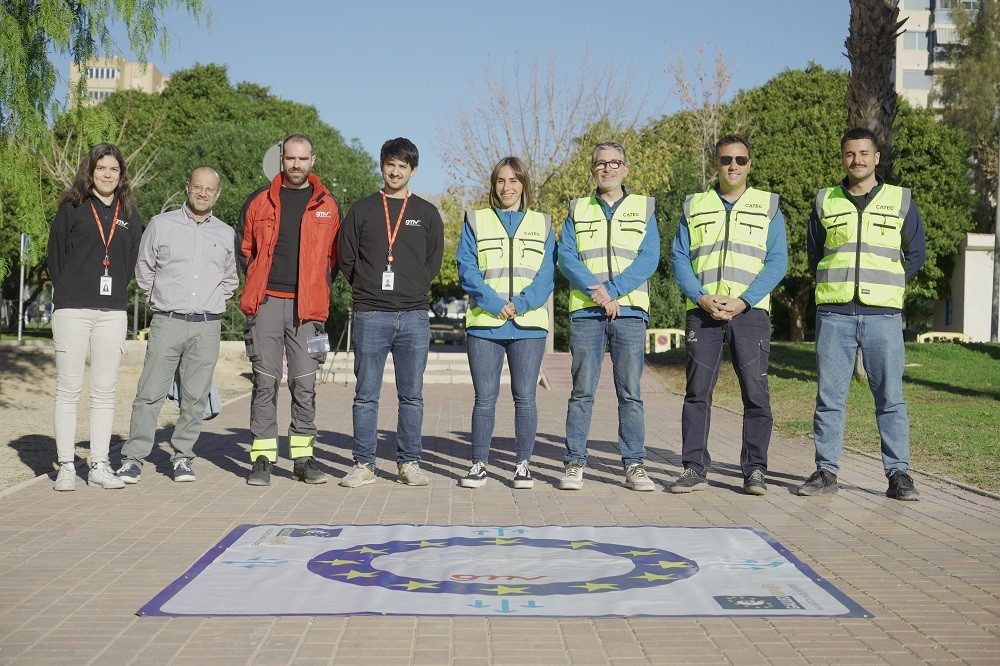Second round of flights in the European Commission's SONORA project
From 20 to 22 November, the second round of flight tests in the SONORA (Support to Standardisation Actions for EGNOS and Galileo in the U-Space) program was carried out. SONORA is a European Commission project developed by a consortium led by VVA Brussels and which includes GMV, CATEC, MCI, and RP Legal & Tax.
Funded by the European Commission, the main goal of SONORA is to develop the future of the U-Space industry and unmanned aerial systems. U-Space covers all the services and procedures being developed to allow for a high number of orderly, smooth, and secure unmanned aircraft operations. The European Commission has established a regulatory framework that will enable automated management of drone traffic in a way that is integrated with manned aircraft. Spain’s Ministry of Transportation, Mobility and the Urban Agenda has established a National Action Plan for the Deployment of U-Space (PANDU) to comply with these EU regulations.
According to European Commission data, the drone services market in Europe could be worth €14.5 billion, and create 145,000 jobs, by 2030.
The SONORA project seeks to transform the industry by incorporating European Global Navigation Satellite System (EGNSS) services into its rules and regulations while encouraging the implementation of GNSS-based solutions in the U-Space environment. The EGNSS is a satellite navigation system offering positioning, navigation, and timing services throughout Europe. It is made up of two main components: the Galileo system and the EGNOS system. Galileo is a global navigation satellite system with 30 satellites in orbit, and EGNOS is a regional system that improves the precision and integrity of satellite navigation systems already in place in Europe.
Two series of flight tests are planned as part of SONORA, one in an open environment and one in an urban environment. The first took place in November 2022 at the ATLAS center (Tactical Center of the Air Traffic Laboratory for Advanced Unmanned Systems) in Jaén. The goal was to collect and analyze GNSS data, gathered by various pieces of equipment and technologies, to support the development and verification of standards and assess several new EGNSS services, such as Galileo HAS (High Accuracy Service) y OS‑NMA (Open Service – Navigation Message Authentication), in an obstacle-free environment.
As such, various missions with unmanned aerial systems (UAS) in real-world situations, such as highway surveillance, vehicle chases, and intrusion detection, were planned and carried out.
An initial analysis of the results from these tests has led to interesting conclusions regarding the GNSS configurations and frequencies used and the influence of the systems involved in controlling the aircraft on the total positioning error. Under similar geometrical conditions in terms of satellite distribution and availability, the accuracy of Galileo is greater than that of GPS, increasing significantly with dual-frequency systems compared to single-frequency systems, with a low margin of error.
Second round of flights, in Benidorm
The second round of flight tests for drones in the SONORA project took place between 20 and 22 November in Benidorm (Alicante province, Spain). Over the course of three days, participants analyzed the results of a study that was similar to the first set of tests, but took place in an urban environment, which is more challenging in terms of navigation, and included the use of GNSS receivers hybridized with other technologies, such as inertial measurement unit (IMU) technology, used to measure the acceleration and angular velocity of an object, allowing for in-depth motion analysis.
The main goal of this second and final test was to collect relevant data on urban aerial mobility for unmanned aerial systems. To do so, the capabilities and performance of hybrid GNSS solutions in urban environments were assessed. Hybrid GNSS solutions are navigation systems that combine GNSS (Global Navigation Satellite System) technology with other sensors, such as cameras, lidar light detection and ranging technology to measure precise distances and movements in real time, IMUs (Inertial Measurement Units), and odometers. These systems are used to improve the accuracy and reliability of navigation in urban and indoor environments, where the GNSS signal may be weak or interrupted. Hybrid GNSS solutions are used in a wide range of applications, such as autonomous vehicle navigation, mobile mapping, precision agriculture, and robotics.
That’s why the consortium in charge of carrying out the project has meticulously planned an exhaustive series of flight plans to assess the accuracy, availability, continuity, and integrity of GNSS receivers integrated with IMUs or other complementary technologies.
The tests will also help evaluate the performance of various GNSS equipment and system technologies (for example, GPS, Galileo, EGNOS, EGNOS's future DFMC, RTK-PPP, etc.) and enhance our understanding of unmanned air system operations in urban environments, through the emulation of Specific Category operations at the SAIL III risk level.
The SAIL III risk level is an index used to assess security risks in drone operations. It is determined based on the Specific Operations Risk Assessment (SORA), which combines ground risk and air risk together with the corresponding mitigation measures applied. Depending on the SAIL level, the operation will be considered higher risk or lower risk. SAIL III is considered medium risk. At this level, a higher level of aircraft robustness is required compared to SAIL I and II.
Based on further analysis of the test results, the consortium will provide feedback to the regulatory agencies with the goal of streamlining the authorization processes for medium-risk Specific Category operations (SAIL III-IV).
More info:
Corporate Marketing & Communications
[email protected]
